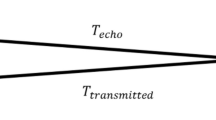Abstract
In this paper, a new algorithm of inverse synthetic aperture radar (ISAR) imaging for three-dimensional (3-D) rotation targets is presented. The characteristic of the received signal when the target has 3-D rotation is studied, and it is approximated as multi-component amplitude modulated and frequency modulated (AM–FM) signal. Then a new algorithm for the adaptive Chirplet decomposition is presented to analyze the AM–FM signal, and the high quality instantaneous ISAR images are obtained based on the Range-Instantaneous-Doppler (RID) algorithm. The results of simulated and real data demonstrate the effectiveness of the method proposed.
Similar content being viewed by others
References
Bao Z., Wang G.Y. (1998) L. L. Inverse synthetic aperture radar imaging of maneuvering targets. Optical Engineering 37(5): 1582–1588
Berizzi F., Mese E.D., Diani M., Martorella M. (2001) High-resolution ISAR imaging of maneuvering targets by means of the range instantaneous Doppler technique: Modeling and performance analysis. IEEE Transactions on Image Processing 10(12): 1880–1890
Carrara W.G., Goodman R.S., Majewski R.M. (1995) Spotlight synthetic aperture radar. Artech House, Norwood, MA
Chen C.C., Andrews H.C. (1980) Targets-motion-induced radar imaging. IEEE Transactions on AES 16(1): 2–14
Chen V.C., Qian S. (1998) Joint time-frequency transform for radar Range-Doppler imaging. IEEE Transactions on AES 34(2): 486–499
Gough P.T. (1994) A fast spectrum estimation algorithm based on the FFT. IEEE Transactions on Signal Processing 42(6): 1317–1322
Li J.F., Ling H., Chen V.C. (2003) An algorithm to detect the presence of 3D target motion from ISAR data. Multidimensional Systems and Signal Processing 14(1–3): 223–240
Lu G.Y., Bao Z. (2000) Compensation of scatterers migration through resolution cell in inverse synthetic aperture radar imaging. IEE Proceedings-Radar Sonar and Navigation 147(2): 80–85
Mann S., Haykin S. (1995) The Chirplet transform: Physical considerations. IEEE Transactions on Signal Processing 43(11): 2745–2761
Sun C.Y., Bao Z. (1999) A super resolution radar imaging algorithm based on the 2-D approximate model. Acta Electronica Sinica 27(12): 84–87
Wehner D.R. (1995) High-resolution radar (2nd ed). Artech House, Norwood, MA
Wood J.C., Barry D.T. (1994) Linear signal synthesis using the Radon-Wigner Transform. IEEE Transactions On Signal Processing 42(8): 2105–2111
Xing M., Wu R., Bao Z. (2005) High resolution ISAR imaging of high speed moving targets. IEE Proceedings-Radar Sonar and Navigation 152(2): 58–67
Author information
Authors and Affiliations
Corresponding author
Rights and permissions
About this article
Cite this article
Wang, Y., Jiang, Y. ISAR imaging for three-dimensional rotation targets based on adaptive Chirplet decomposition. Multidim Syst Sign Process 21, 59–71 (2010). https://doi.org/10.1007/s11045-009-0087-2
Received:
Revised:
Accepted:
Published:
Issue Date:
DOI: https://doi.org/10.1007/s11045-009-0087-2




